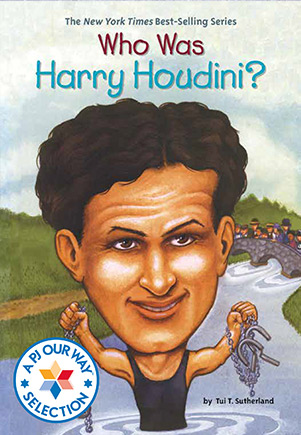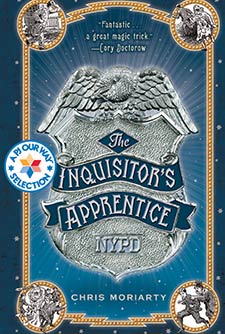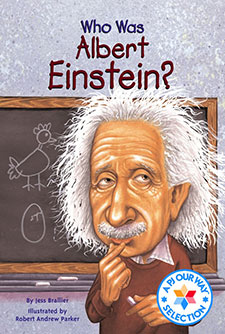Who Was Harry Houdini?
If you were sealed inside a giant metal milk can filled with water, could you escape? You could if you were Harry Houdini, the most famous magician in the world!
Average Rating
( hint: Login to leave a review! )
153 Reviews
Leave Review
What the Book is About
Jewish Content & Values
Positive Role Models
Content Advisory
Talk it Over!
More for You
What the Book is About
For kids who love magic, this is a fast-paced, informative, and exciting biography of the legendary Harry Houdini. The mystery surrounding Houdini begins with his origins: while records show that he was born in Hungary, Houdini sometimes claimed to have been born in America, and he often gave different birth dates. While painting a picture of his struggles, his persistence in becoming a master of illusion, his successes in America and Europe, and his marriage, this biography looks at Houdini’s motivations and ambitions, and even revealing some of the tricks behind his magic.
Jewish Content & Values
- Beyond being born Ehrich Weiss, the son of a Hungarian Rabbi, Judaism was not a big part of Houdini’s everyday life. Houdini married Bess Raymond (Wilhelmina Rahner), a woman who was not Jewish and who never converted. Despite the fact that he did not identify as a religious Jew, Houdini was shocked at the anti-Semitism he witnessed in Russia and was buried near his parents in New York’s Jewish Machpelah Cemetery.
- Houdini truly exemplified the Jewish value of honoring one’s parents (Kibbud Horim). Before his premature death, Houdini’s father made Houdini promise that he would always take care of his mother. Houdini was true to his word and loved and treated his mother with the utmost respect for the rest of her life. Even when Houdini was struggling financially, he made sure to provide for his mother and make her comfortable in his home.
Positive Role Models
Harry Houdini’s immense ambition and need for public attention fueled his determination to become the best magician and escape artist the world had ever seen. Houdini’s illusionary tricks and escape acts took exceptional skill, extreme creativity, and tremendous practice. He demonstrated determination, persistence, and a natural knack for self-marketing!
Content Advisory
None.
Talk it Over!
Emet (truth) is an elusive concept when dealing with magic and illusion. Houdini concealed his personal life and background to heighten his mystique, and most of his tricks involved misdirection, such as “magician’s patter.” Is it always wrong to fool people? Is it ever okay to tell a lie?
More for You
The Torah verse Lifnei iver lo titen michshol (Before a blind person do not place a stumbling block) (Deuteronomy 19:14) is generally understood as a prohibition against tricking people. Ironically, while Houdini’s career was based on tricks, he was an outspoken critic of Spiritualism, a popular post-World War I movement that promoted communication with the dead. While his illusions were performed for pure entertainment, Houdini felt that Spiritualism was the worst kind of trickery because it exploited the vulnerabilities of people who felt empty after the loss of a loved one.
What the Book is About
What the Book is About
For kids who love magic, this is a fast-paced, informative, and exciting biography of the legendary Harry Houdini. The mystery surrounding Houdini begins with his origins: while records show that he was born in Hungary, Houdini sometimes claimed to have been born in America, and he often gave different birth dates. While painting a picture of his struggles, his persistence in becoming a master of illusion, his successes in America and Europe, and his marriage, this biography looks at Houdini’s motivations and ambitions, and even revealing some of the tricks behind his magic.
Jewish Content & Values
Jewish Content & Values
- Beyond being born Ehrich Weiss, the son of a Hungarian Rabbi, Judaism was not a big part of Houdini’s everyday life. Houdini married Bess Raymond (Wilhelmina Rahner), a woman who was not Jewish and who never converted. Despite the fact that he did not identify as a religious Jew, Houdini was shocked at the anti-Semitism he witnessed in Russia and was buried near his parents in New York’s Jewish Machpelah Cemetery.
- Houdini truly exemplified the Jewish value of honoring one’s parents (Kibbud Horim). Before his premature death, Houdini’s father made Houdini promise that he would always take care of his mother. Houdini was true to his word and loved and treated his mother with the utmost respect for the rest of her life. Even when Houdini was struggling financially, he made sure to provide for his mother and make her comfortable in his home.
Positive Role Models
Positive Role Models
Harry Houdini’s immense ambition and need for public attention fueled his determination to become the best magician and escape artist the world had ever seen. Houdini’s illusionary tricks and escape acts took exceptional skill, extreme creativity, and tremendous practice. He demonstrated determination, persistence, and a natural knack for self-marketing!
Content Advisory
Content Advisory
None.
Talk it Over!
Talk it Over!
Emet (truth) is an elusive concept when dealing with magic and illusion. Houdini concealed his personal life and background to heighten his mystique, and most of his tricks involved misdirection, such as “magician’s patter.” Is it always wrong to fool people? Is it ever okay to tell a lie?
More for You
More for You
The Torah verse Lifnei iver lo titen michshol (Before a blind person do not place a stumbling block) (Deuteronomy 19:14) is generally understood as a prohibition against tricking people. Ironically, while Houdini’s career was based on tricks, he was an outspoken critic of Spiritualism, a popular post-World War I movement that promoted communication with the dead. While his illusions were performed for pure entertainment, Houdini felt that Spiritualism was the worst kind of trickery because it exploited the vulnerabilities of people who felt empty after the loss of a loved one.




